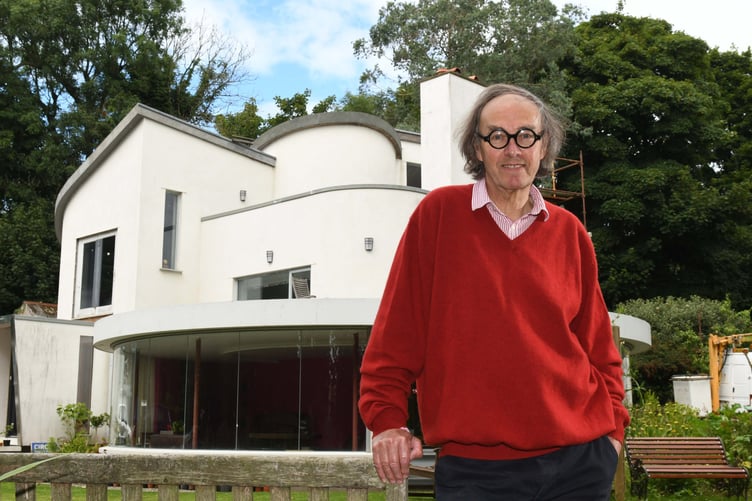A new book, written by an acknowledged world-wide expert in building with natural materials and techniques, has featured a house, built out of hemp and lime, on the Isle of Man.
‘Natural Building Techniques: A Guide to Ecological Methods and Materials’, has been written and released by Tom Woolley, an architect, educator and builder who has campaigned for a wider use in green and low-impact building materials since the 1990s.
In its pages, under the chapter entitled ‘Hemp and Hempcrete’, is featured the self-built, architecturally-fascinating house built by restaurant owner Nigel Kermode in Greeba.
Over the past 10 years, Nigel has designed and built his art-deco-influenced house using the relatively-unknown building material ‘Hempcrete’.
Made from the waste pith of the hemp plant stalk mixed with lime and water to make a concrete-like substance, hempcrete, Nigel, with help from architect Ashley Pettit and experts such as Tom, has built his low impact, environmentally sound home and hopes it can inspire others to look around at alternative substances to build from in the future.
A former art student with a background in architectural studies, Nigel decided he wanted to design and build his own house and took it upon himself to investigate alternative building techniques.
He came across Tom and the idea of hempcrete while taking part in a lime-working course in Edinburgh.
Nigel said: ‘I thought I’d find out more about lime, as it can be used in various creative ways and, if I was going to build my own house, I’d have a bit of fun with it. If I wanted an ordinary house, I’d just go and buy one. So why not try something interesting instead?
‘I had a background in art and architecture, and I knew enough about artistic major architects to give me an idea of what I wanted.
‘I decided on using hempcrete, as it enabled you to create rounded and curved walls, and to create unconventional shapes.’
Nigel’s house was built around a timber frame structure, with timbered internal walls.
‘The outside was shuttered off and the external walls were made by mixing the hempcrete by hand on site and pouring it into the shuttering, creating a solid cast wall.
The hemp used in making hempcrete is part of the stalk of the highly adaptable and useful plant, which doesn’t contain any of the THC properties of cannabis.
The tough stalks are processed for their fibre, which are used for a multitude of uses, including clothing, textiles and rope-making, and the resulting pith, the inside of the stalk, was considered a waste material and was often used for horse bedding, if not thrown away.
‘The hemp plant is a very useful plant,’ said Nigel.
‘It grows tall, in a similar way to bamboo and, when you break the stalks apart to get the fibres, you get a lot of cork-like pith.
‘It was discovered that the pith contains these wonderful insulation properties. It is filled with a lot of micro holes that holds air and moisture. The result is a house that has terrific qualities of insulation, breathability and its got thermal mass, which means it keeps its heat once it gets warm.
‘There’s no waterproofer, or plastic, or chemical agents inside it. It’s painted in whitewash and the idea is that the walls are breathable and inside the house, it generates a nice atmosphere. The walls maintain a nice balance, not too dry, and not overly moist.’
Using the material on the Isle of Man was not straightforward.
As an inert part of the hemp plant, Nigel was able to have bales of the material shipped to the island relatively easily.
However, he faced a battle to gain the permission to build using it.
‘I had to negotiate with building control, as the product wasn’t an acknowledged building material over here, and I had to get them to change their legislation on this product so it can be used,’ he said.
‘I visited a few places in England, big structures that had been built with this material, and I also brought over a man who trades in the product and who I’d be buying it from to talk to the experts about it.
‘We gave a presentation to government and to building control, and they accepted it on the basis that it had been accepted as a building technique in England already.
‘The hemp is cheap to buy, as it is a waste product, but it’s slow to work with, there’s no equipment on the island to use it properly and there’s no experience in using and building with it, so that made it a quite expensive project.
‘I did look into the possibility of growing my own hemp,’ he added.
‘It grows to be quite a huge plant and an acre can easily provide you with the hemp you need to build a place. But the law is, or was, that you can’t grow it, simple as that.
‘Although, I do like the idea of being able to grow your own house.’





Comments
This article has no comments yet. Be the first to leave a comment.